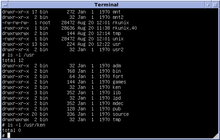Ancient UNIX is any early release of the Unix code base prior to Unix System III, particularly the Research Unix releases prior to and including Version 7 (the base for UNIX/32V as well as later developments of AT&T Unix).



After the publication of the Lions' book, work was undertaken to release earlier versions of the codebase. SCO first released the code under a limited educational license.[citation needed]
Later, in January 2002, Caldera International (now SCO Group) relicensed (but has not made available) several versions under the four-clause BSD license, namely:[1][2]
- Research Unix: (early versions only)
- Version 1 Unix
- Version 2 Unix
- Version 3 Unix
- Version 4 Unix
- Version 5 Unix
- Version 6 Unix
- Version 7 Unix
As of 2022[update], there has been no widespread use of the code, but it can be used on emulator systems, and Version 5 Unix runs on the Nintendo Game Boy Advance using the SIMH PDP-11 emulator.[3] Version 6 Unix provides the basis for the MIT xv6 teaching system, which is an update of that version to ANSI C and the x86 or RISC-V platform.
The BSD vi text editor is based on code from the ed line editor in those early Unixes. Therefore, "traditional" vi could not be distributed freely, and various work-alikes (such as nvi) were created. Now that the original code is no longer encumbered, the "traditional" vi has been adapted for modern Unix-like operating systems.[4]
SCO Group, Inc. was previously called Caldera International. As a result of the SCO Group, Inc. v. Novell, Inc. case, Novell, Inc. was found to not have transferred the copyrights of UNIX to SCO Group, Inc.[5] Concerns have been raised regarding the validity of the Caldera license.[6][7]
The Unix Heritage Society edit
The Unix Heritage Society was founded by Warren Toomey.[8][9][10][11][12][13][14][excessive citations] First edition Unix was restored to a usable state by a restoration team from the Unix Heritage Society in 2008. The restoration process started with paper listings of the source code which were in PDP-11 assembly language.[15][16]
References edit
- ^ Johnson II, Dion L. (2002-01-24). "Liberal license for ancient UNIX sources".
- ^ Broderick, Bill (January 23, 2002). "Dear Unix enthusiasts" (PDF). Caldera International. Archived from the original (PDF) on February 19, 2009.
- ^ Singh, Amit (August 2004). "UNIX® on the Game Boy Advance". Archived from the original on 2006-08-31. Retrieved 2009-10-22.
- ^ "The Traditional Vi".
- ^ "10th Circuit Court of Appeals Decision" (PDF).
- ^ Warren Toomey. "The Push to Get Free Unix Licenses".
- ^ "Why BSD/OS is the best candidate for being the only tested legally open UNIX".
- ^ "Interview with Warren Toomey, Founder of the Unix Heritage Society". USENIX. 13 January 2023. Retrieved 15 June 2023.
- ^ Davis, A. Jesse Jiryu (June 14, 2017). "Assembling the history of Unix". LWN.net. Retrieved 15 June 2023.
- ^ Jude, Allan (October 13, 2022). "Warren Toomey interview". BSD Now. Retrieved 15 June 2023. MP3 44:34
- ^ Chirgwin, Richard. "Samizdat no more: Old Unix source code opened for study". theregister.com. Retrieved 15 June 2023.
- ^ "Warren Toomey : contributions". researchgate.net. Retrieved 15 June 2023.
- ^ "SCO may not know origin of code, says Australian UNIX historian". The Sydney Morning Herald. 9 September 2003. Retrieved 15 June 2023.
- ^ Toomey, Warren (2010). "First Edition Unix: Its Creation and Restoration". IEEE Annals of the History of Computing. 32 (3): 74–82. ISSN 1934-1547. Retrieved 15 June 2023.
- ^ Toomey, Warren (July 2010). "First Edition Unix: Its Creation and Restoration". IEEE Annals of the History of Computing. 32 (3): 74–82. doi:10.1109/MAHC.2009.55. S2CID 18586380.
- ^ The Restoration of Early UNIX Artifacts
External links edit
- Pamela Jones (August 23, 2003) Ancient UNIX Released Under What Terms?, Groklaw
- The Unix Heritage Society (TUHS), for the preservation and maintenance of historical UNIX systems
- code, disk images, and related at TUHS
- Unix First Edition Manual Pages
- Restoration of 1st Edition UNIX kernel sources from Bell Laboratories